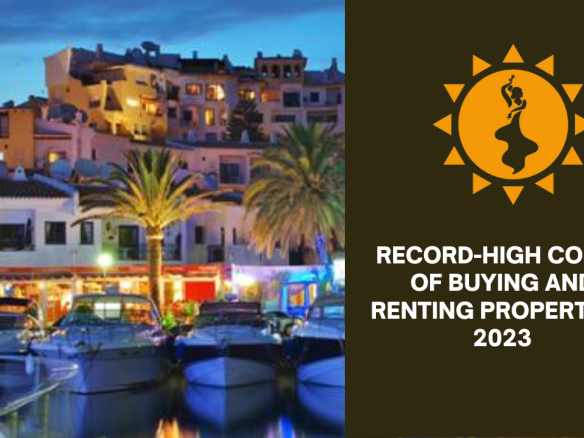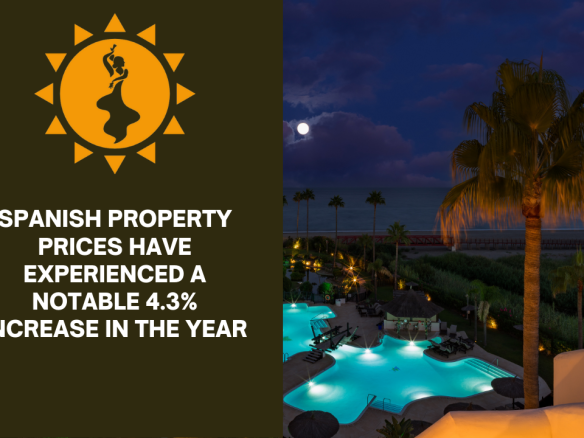Two other towns on the Costa del Sol also saw prices rise above 10%, hitting all-time highs, according to property listings website Idealista
Marbella: Leading the Charge in Spain’s Housing Market Surge
If there’s one place in Spain that exemplifies the soaring housing market, it’s undoubtedly Marbella. The picturesque town on the Costa del Sol has witnessed the highest increase among all large Spanish municipalities in the past year. A staggering surge of 19.9% in property prices has been recorded, setting an unprecedented milestone of an average cost of 4,121 euros per square metre. These figures, based on data compiled by the Idealista property portal, underscore the remarkable growth Marbella’s real estate market has experienced.
But Marbella is not the only town in Malaga province witnessing such remarkable spikes in property prices. Mijas and Fuengirola have also seen their prices rise above 10%, achieving all-time highs of 14.2% and 12.1% respectively. Even the capital, Malaga, has witnessed an 8% increase in prices between January 2022 and January 2023.
These figures stand significantly above the national average year-on-year increase of 5.4%, as reported by Spain’s National Institute of Statistics (INE). Clearly, Marbella and its neighboring towns are spearheading the nation’s impressive surge in property prices, making the Costa del Sol region an attractive and thriving hub in Spain’s ever-evolving housing market.
Provincial capitals
Idealista included 16 provincial capitals in its report that have registered year-on-year increases in house prices higher than inflation. Santa Cruz de Tenerife (18.7%), Alicante (13.2%), Valencia (11.4%), Guadalajara (11.3%) and Cuenca (10.8%) lead the way with double-digit increases.
Important residential markets such as Palma (9.9%), have the highest average price among those 16 capitals, with 3,467 euros/m2. Seville (8.1%) and Malaga (8%), also reached all-time highs with 2,365 euros per square metre.
Along with them, other provincial capitals such as Segovia (9.9%), Pontevedra (8.3%), Badajoz (7.3%), Huelva (7.2%), A Coruña (6.8%), Tarragona ( 6.6%), Granada (6.3%) and Pamplona (5.8%) complete the markets that have grown more than the CPI for the first month of the year.
Only six registered a drop in average house prices year-on-year. Palencia (-3.5%), Zamora (-2.5%), Ceuta (-2.4%), Jaén (-2.2%), León (-0.4%) and Ávila (-0 ,3%). Ávila (1,078 euros/m2) and Jaén (1,083 euros/m2) have some of the cheapest housing prices among these cities.
Large metropolitan areas
Madrid saw a price increase of 4.9% in the metropolitan area and increases above inflation in nine different locations. Alcorcón (10.8%) and Rivas-Vaciamadrid (10.6%), Leganés (9.5%), Las Rozas de Madrid (8.3%), Coslada (7.5%) %), Alcobendas (7.4%), Alcalá de Henares (7.2%), Torrejón de Ardoz (6.9%) and Móstoles (6.8%)
In Barcelona, the increases in the metropolitan area were not as steep as that of Madrid. Sant Cugat del Vallès (6.6%) and Mataró (6.5%) districts, however, stand out still above inflation.
Hospitalet de Llobregat (4.9%) and Cornellà (3.8%) present increases that are still higher than the city of Barcelona itself (3%), followed by Terrassa (2.8%), Sabadell (2.6% ), Sant Boi de Llobregat (2.5%), Santa Coloma de Gramanet (1.7%) and closes Badalona (0.8%).
Three other areas had notable increases. Alicante (13.2%) and the most prominent towns in its surroundings, such as Elche (8.1%), Torrevieja (16.1%) and Orihuela (18.5%).
Cádiz also stands out (4.7%), where while the capital grows below the CPI, while close-by towns Jerez de la Frontera (14.4%) and Puerto de Santa María (14%), grew at twice the rate of inflation, together with Chiclana (9 .3%) and San Fernando (7.7%).





